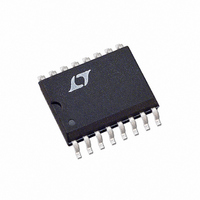LT1376CS Linear Technology, LT1376CS Datasheet - Page 11

LT1376CS
Manufacturer Part Number
LT1376CS
Description
IC SW REG 1.5A ADJ STP-DWN16SOIC
Manufacturer
Linear Technology
Type
Step-Down (Buck)r
Datasheet
1.LT1376CS8PBF.pdf
(28 pages)
Specifications of LT1376CS
Internal Switch(s)
Yes
Synchronous Rectifier
No
Number Of Outputs
1
Voltage - Output
2.42 ~ 21.5 V
Current - Output
1.5A
Frequency - Switching
500kHz
Voltage - Input
5 ~ 25 V
Operating Temperature
0°C ~ 125°C
Mounting Type
Surface Mount
Package / Case
16-SOIC (3.9mm Width)
Lead Free Status / RoHS Status
Contains lead / RoHS non-compliant
Power - Output
-
Available stocks
Company
Part Number
Manufacturer
Quantity
Price
Part Number:
LT1376CS
Manufacturer:
LINEAR/凌特
Quantity:
20 000
Company:
Part Number:
LT1376CS-5
Manufacturer:
AGERE
Quantity:
1 314
Part Number:
LT1376CS8
Manufacturer:
LINEAR/凌特
Quantity:
20 000
Part Number:
LT1376CS8#PBF
Manufacturer:
LINEAR/凌特
Quantity:
20 000
Company:
Part Number:
LT1376CS8#TR
Manufacturer:
LINEAR
Quantity:
7 388
Company:
Part Number:
LT1376CS8#TRPBF
Manufacturer:
LINEAR
Quantity:
10 119
Part Number:
LT1376CS8#TRPBF
Manufacturer:
LINEAR/凌特
Quantity:
20 000
Part Number:
LT1376CS8-5
Manufacturer:
LINEAR/凌特
Quantity:
20 000
Company:
Part Number:
LT1376CS8-5#TR
Manufacturer:
LT
Quantity:
41
APPLICATIONS
Example: with L = 2µH, V
The main reason for using such a tiny inductor is that it is
physically very small, but keep in mind that peak-to-peak
inductor current will be very high. This will increase output
ripple voltage. If the output capacitor has to be made larger
to reduce ripple voltage, the overall circuit could actually
wind up larger.
CHOOSING THE INDUCTOR AND OUTPUT CAPACITOR
For most applications the output inductor will fall in the
range of 3µH to 20µH. Lower values are chosen to reduce
physical size of the inductor. Higher values allow more
output current because they reduce peak current seen by
the LT1376 switch, which has a 1.5A limit. Higher values
also reduce output ripple voltage, and reduce core loss.
Graphs in the Typical Performance Characteristics section
show maximum output load current versus inductor size
and input voltage. A second graph shows core loss versus
inductor size for various core materials.
When choosing an inductor you might have to consider
maximum load current, core and copper losses, allowable
component height, output voltage ripple, EMI, fault cur-
rent in the inductor, saturation, and of course, cost. The
following procedure is suggested as a way of handling
these somewhat complicated and conflicting requirements.
1. Choose a value in microhenries from the graphs of
I
OUT MAX
maximum load current and core loss. Choosing a small
inductor with lighter loads may result in discontinuous
mode of operation, but the LT1376 is designed to work
well in either mode. Keep in mind that lower core loss
means higher cost, at least for closed core geometries
like toroids. The core loss graphs show both absolute
loss and percent loss for a 5W output, so actual percent
losses must be calculated for each situation.
Assume that the average inductor current is equal to
load current and decide whether or not the inductor
( )
=
( )
1 5
.
2
⎛
⎝
U
500 10
2 5 15 5
( )
INFORMATION
•
OUT
U
(
3
= 5V, and V
⎞
⎠
⎛
⎝
−
2 10
•
)
W
−
6
⎞
⎠
IN(MAX
( )
15
U
=
) = 15V,
338
mA
2. Calculate peak inductor current at full load current to
3. Decide if the design can tolerate an “open” core geom-
4. Start shopping for an inductor (see representative
must withstand continuous fault conditions. If maxi-
mum load current is 0.5A, for instance, a 0.5A inductor
may not survive a continuous 1.5A overload condition.
Dead shorts will actually be more gentle on the induc-
tor because the LT1376 has foldback current limiting.
ensure that the inductor will not saturate. Peak current
can be significantly higher than output current, espe-
cially with smaller inductors and lighter loads, so don’t
omit this step. Powdered iron cores are forgiving
because they saturate softly, whereas ferrite cores
saturate abruptly. Other core materials fall in between
somewhere. The following formula assumes continu-
ous mode of operation, but it errs only slightly on the
high side for discontinuous mode, so it can be used for
all conditions.
V
f = Switching frequency, 500kHz
etry like a rod or barrel, which have high magnetic field
radiation, or whether it needs a closed core like a toroid
to prevent EMI problems. One would not want an open
core next to a magnetic storage media, for instance!
This is a tough decision because the rods or barrels are
temptingly cheap and small and there are no helpful
guidelines to calculate when the magnetic field radia-
tion will be a problem.
surface mount units in Table 2) which meets the re-
quirements of core shape, peak current (to avoid satu-
ration), average current (to limit heating), and fault
current (if the inductor gets too hot, wire insulation will
melt and cause turn-to-turn shorts). Keep in mind that
all good things like high efficiency, low profile, and high
temperature operation will increase cost, sometimes
dramatically. Get a quote on the cheapest unit first to
calibrate yourself on price, then ask for what you really
want.
IN
I
PEAK
= Maximum input voltage
=
I
OUT
+
V
OUT
2
( )( )( )
(
f L V
V
IN
−
LT1375/LT1376
V
IN
OUT
)
11
13756fd














